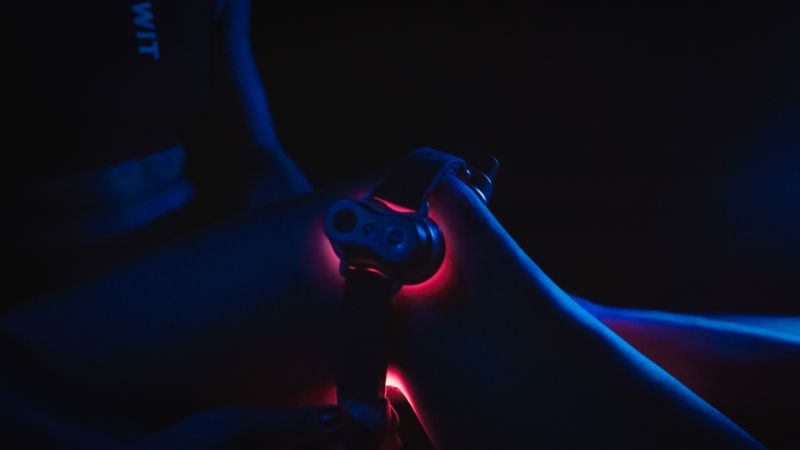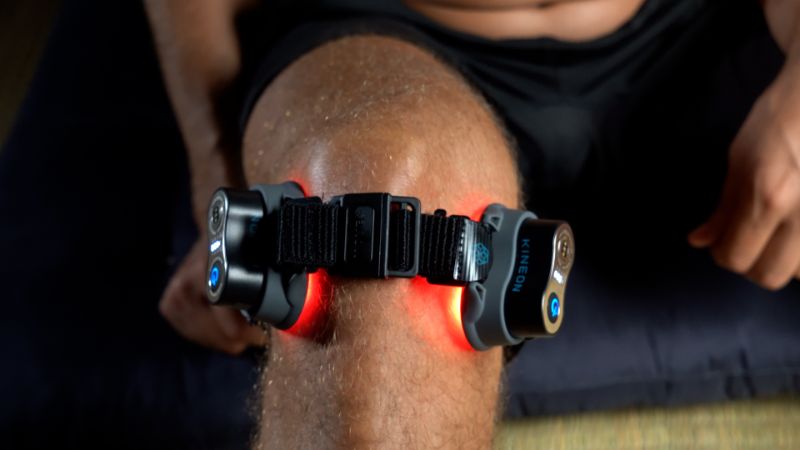
808nm Versus 850nm What is the Difference?
Share
Have you ever wondered about the differences between 808nm and 850nm wavelengths and how they can impact your therapeutic outcomes? Well, look no further because we've got you covered!
It’s no wonder many people are curious about these two near-infrared (NIR) wavelengths. They are showing up more and more in medical practices, with both showing tremendous therapeutic benefits to the body.
Our comprehensive guide will explain the differences and similarities of 808nm and 850nm wavelengths, as well as how these light waves work differently in your body's system so that you can decide which treatment is best suited to your needs.
So, if you're ready to expand your knowledge and make informed decisions about which wavelength suits your needs best, join us as we explore the captivating world of 808nm versus 850nm.
Let's unravel the mysteries together and unlock the full potential of these wavelengths!
Wavelengths Explained

When it comes to wavelengths, not all are created equal.
Red light, typically ranging between 630nm and 660nm, is visible to the human eye and is known for its ability to penetrate the skin at a shallow depth.
Red light wavelengths are renowned for their therapeutic properties, offering benefits such as skin rejuvenation, wound healing, muscle recovery, and pain reduction.
If you would like to know more about these specific red light wavelengths, check out our blog Red Light Wavelengths: Everything You Need To Know to find out more!
On the other hand, near-infrared wavelengths, specifically in the range of 800nm to 808nm, fall outside the visible spectrum.
These wavelengths have been shown to have a range of therapeutic benefits for our bodies, such as reducing inflammation, relieving pain, and increasing blood flow. This is due to their longer wavelength and lower frequency, allowing them to penetrate further than red wavelengths.
To find out more about the differences between red light therapy and near infrared therapy, check out our blog Red Light Therapy VS Near Infrared VS Infrared: Key Differences Explained.
By understanding the differences between red and near-infrared wavelengths, we can unlock the amazing potential of red light therapy and take advantage of its beneficial effects on our overall well-being.
What is the Difference Between NIR Wavelengths?

Near-infrared wavelengths have become increasingly popular in the health and wellness industry, having been found to have a variety of therapeutic benefits for the body.
In the world of NIR wavelengths, three remarkable players deserve our attention: 808nm, 830nm, 850nm. These specific wavelengths hold immense potential for red light therapy and can offer unique benefits for our well-being.
But what exactly is the difference between these specific wavelengths? Each wavelength has its own unique characteristics that affect the way it interacts with the body. Understanding these differences is crucial in utilizing near-infrared therapy to its greatest potential.
So, let’s delve into the distinctive qualities and therapeutic advantages each wavelength brings to the table!
830nm
Numerous studies have highlighted the therapeutic potential of the 830nm wavelength.
When applied, it penetrates deeply into tissues, accelerating the healing process and increasing blood circulation. This makes it particularly useful in the treatment of musculoskeletal conditions, like arthritis, where it can relieve pain and inflammation, and speed up recovery times (2).
A compelling study revealed that 830nm wavelengths can also play a significant role in speeding up the healing process in individuals who have undergone invasive surgical procedures. The study demonstrated that when exposed to the 830nm wavelength, the healing time for surgical wounds was significantly reduced compared to the control group (3).
These findings demonstrate the remarkable efficacy of the 830nm wavelength in pain management and boosted recovery times. Typically, however, these studies show less of a substantial impact than 808nm.
850nm
850nm emitters as LEDs were adopted early by security camera producers and because of this have been more widely available and less expensive than other NIR wavelengths. Numerous studies have highlighted the therapeutic potential of the 850nm wavelength, including its ability to promote cellular regeneration and alleviate chronic pain, however, it is worth noting that typically the impacts from the 850nm are less effective than 808nm.
Research has shown that the 850nm wavelength can penetrate deep into tissues, stimulating mitochondrial activity and enhancing cellular energy production. This, in turn, promotes tissue repair and regeneration.
A notable study focused on nurses suffering from chronic back pain found that exposure to the 850nm wavelength significantly reduced pain levels. (4)
By penetrating deep into tissues, this wavelength stimulates mitochondria, which in turn enhances cellular energy production and promotes tissue regeneration, but by direct comparison, this shows less impact than 808nm.
808nm – The Gold Standard of NIR Light Therapy
When it comes to therapeutic effects on the body, 808nm is definitely a wavelength you should keep on your radar.
This is the most impactful from the largest number of clinical trials and is used in most clinical-level devices.
It’s one of the least available on the market though because of the manufacturing processes, and because of this is usually more expensive and harder to find.
Research has shown that the 808nm wavelength holds tremendous therapeutic potential for various applications, particularly for wound healing and cellular regeneration.
Studies have also demonstrated that the 808nm wavelength, with its deep tissue penetration, can effectively target affected joints and alleviate symptoms associated with osteoarthritis (5).
By stimulating cellular activity and enhancing mitochondrial function, this wavelength promotes tissue regeneration and helps reduce pain and inflammation.
Additionally, scientific evidence suggests that the 808nm wavelength can play a significant role in reducing tiredness during physical activity when utilized beforehand (6).
One study demonstrated that when applied to wounds, the 808nm wavelength stimulated cellular activity, promoting faster healing and encouraging the production of collagen, a vital protein responsible for tissue strength and regeneration (7).
Pre-exposure to the 808nm wavelength has been shown to enhance cellular energy production, optimize muscle performance, and improve exercise endurance.
As a result, athletes and individuals involved in physical activities can combat fatigue and enhance performance through a scientifically-backed approach.
Scientific research has shed light on the remarkable efficacy of the 808nm wavelength in promoting tissue repair and rejuvenation, making it a valuable tool in managing challenging conditions.
The one downside for the 808nm emitters is that they are less widely available and more expensive from a supply chain standpoint so most cheap products do not include this wavelength; particularly in the laser form which is most effective in internal tissue dosing.
Comparing the two: 808nm vs 850nm

Both wavelengths have unique characteristics that can benefit the body, but understanding which to use in each situation is crucial.
As discussed earlier, scientific research has highlighted the unique advantages of each wavelength, showcasing their efficacy in different therapeutic applications.
The 808nm wavelength is better suited for treating deeper tissues, such as tendons and joints, due to its longer wavelength and greater depth penetration.
It also proves to be a valuable tool in supporting athletic performance, as it promotes tissue repair, reduces inflammation, and enhances cellular energy production.
On the other hand, because of the supply chain availability and price the 850nm wavelength is a better-suited option for inexpensive LED-based light therapy solutions
Understanding the distinctive qualities of each wavelength allows for a tailored approach to red light therapy.
By leveraging 808nm wavelength for treating serious conditions and supporting physical performance, individuals can optimize their red light therapy regimen to address specific needs.
Which NIR Wavelength Is Best For You?

Near-infrared therapy is becoming increasingly popular as a natural way to support the body's healing processes. But with so many different wavelengths available, it can be tough to know which one is best suited for your needs.
Determining the optimal wavelength for your specific needs in red light therapy requires careful consideration and understanding of your desired therapeutic outcomes.
If you're dealing with more superficial or minor injuries, the 808nm wavelength is a great choice. This wavelength penetrates the skin surface just deep enough to provide the healing energy your body needs to jumpstart the regeneration process.
If you are primarily seeking a way to save money on a light therapy product, the 850nm wavelength may be a suitable choice.
But if you're dealing with deeper tissue damage or just want to improve your physical performance, and reduce pain and inflammation then the 808nm wavelength is a better option.
This powerful wavelength can penetrate deeper into the body, providing the support needed to reach those deeper tissues and help speed up the healing process.
Remember, each person's response to red light therapy can vary, and it may be beneficial to start with a lower intensity and gradually increase treatment duration and frequency as you monitor your body's response.
By making an informed decision based on your desired therapeutic outcomes and seeking expert advice when needed, you can select the wavelength that best aligns with your unique needs and embark on a red light therapy journey with confidence.
No matter which option you choose, near-infrared therapy can be a great addition to your healthcare routine and promote overall wellness.
Conclusion
To achieve the best therapeutic outcomes, it's important to consider using both red light therapy and near infrared therapy. These modalities offer diverse and remarkable benefits for the body, each excelling in different areas to cater to specific therapeutic needs.
By combining the distinct qualities of both therapies, individuals can optimize their red light therapy experience.
Our MOVE+ Pro device has got you covered, bringing you the best of both worlds by combining both types of therapy into one super convenient device!
Our device combines highly targeted enhanced LED lights and medical-grade lasers to provide precise and effective therapy.
The LEDs emit a wavelength of 660nm (deep red LEDs), targeting the upper layers of the skin, while the lasers boast a powerful 808nm (NIR lasers) wavelength, penetrating deep into joints and muscle tissue for fast and accurate relief.
Our unique design ensures pinpoint accuracy on your problem areas, delivering swift and effective results, in less than 20 minutes per day!
If you're eager to learn more about our MOVE+ Pro LED and Laser red light therapy device, simply click the link below and dive into the details!
Click Here To Shop The MOVE+ Pro!
- https://pubmed.ncbi.nlm.nih.gov/23619627/
- https://pubmed.ncbi.nlm.nih.gov/27141153/
- https://www.ncbi.nlm.nih.gov/pmc/articles/PMC4751092/
- https://www.ncbi.nlm.nih.gov/pmc/articles/PMC7592994/
- https://www.sid.ir/en/VEWSSID/J_pdf/1019120120205.pdf
- https://www.ncbi.nlm.nih.gov/pmc/articles/PMC8706093/
- https://pubmed.ncbi.nlm.nih.gov/23619627/
